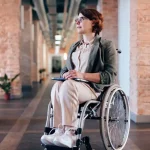Reduce the Risk of Falls
Elderly people with dementia have a higher risk of falls due to dementia. Their condition makes their senses seem off, makes it hard for them to talk, and makes it hard for them to move around.
Often, people with dementia do not have a reality-based interpretation of their environment. They may misperceive shadows, colors, patterns, and light and make interpretations based on those misperceptions.
Also, lack the communication skills can prevent their ability to tell caregivers that what they are seeing and how it could be different from what the caregiver sees. They are likely to react emotionally with fear or reluctance, making their behavior seem unreasonable to a caregiver.
This can interfere in unexpected ways and at odd times when doing even routine things around the house. For Example, going up and down steps, even with careful assistance, may suddenly cause hesitation and fear when the patient does not perceive the edge of the steps.
Stepping into a bathtub may seem like stepping into a deep hole for a dementia patient. Shadows indoors and outdoors are real figures. These experiences can be frustrating to both the patient and the caregiver.
How can a caregiver reduce the risk of falls for a dementia patient who has sensory misperception due to dementia? Realize that certain factors can cause sensory misperceptions.
Light, Shadows, and Colors
Lighting in the home is very important. Make sure that walkways, halls, and bathrooms are well-lit. Be aware of shadows in the bathroom and bedroom, in particular, which may cause alarm or hesitation if the patient misperceives them.
Dark areas in a room may cause the patient to become fearful. Good lighting is helpful in preventing falls for everyone.
Colors on surfaces can fool a dementia patient. If the bathtub has a white surface and the bathmat on the bottom is black, it could be interpreted by the patient as a whole, not the floor of the tub.
Patterns in carpet, tiles and flooring can fool the eyes, and become a distraction to the patient. If the top of the stair and the floor have the same color of carpet, how can the patient clearly tell where the stair stops and the floor begins?
Be sensitive to understand how colors and patterns of the flooring can cause hesitation and stumbling simply because of misperception by the patient.
Tips for Risky Areas
Steps, stairways, and changes in floor height may pose problems for patients. All steps should have handrails beside them. Prevent falls for dementia patients by marking the edges of stairs with colored non-slip tape, so the edge is clearly different from the floor.
If possible, allow the patient to avoid the stairs and take a route on a completely level floor instead. It might be helpful to use a threshold ramp in a doorway to ease transitions from a room to a porch or a lower-level floor surface.
Outdoors, steps can be painted different colors for visibility, then covered with a gritty sand to provide traction.
In the bathroom, safety is paramount. It should be obvious where the patient should put their feet to step into the tub. Non-slip bathtub or shower mats should be a contrasting color to the surface of the tub, but not black.
You might want to mark the edges of the tub with colored tape also. Having a colored commode lid which contrasts with color of the commode, floor and wall can help define the seat for the patient.
Wall mirrors and cabinet mirrors may produce glare or cause the patient to be distracted or confused. Install grab bars that contrast with the colors of the shower surround or walls. Keep mirrors out of sight until they are needed for grooming.
Caregivers should know that the environment has a big effect on how likely a dementia patient is to fall. Lights, colors, and shadows can affect the dementia patient’s mobility in the home.
As you do your daily activities, caregivers can avoid unnecessary risks of falling. Making a few simple changes can help you reduce falls in dementia patients.
In Summary
Dementia patients have a higher risk of falls due to their condition, causing misperceptions of the senses, communication difficulties, and coordination difficulties.
Caregivers can reduce the risk of falls by ensuring the home is well-lit, being aware of shadows and patterns that may cause confusion, and making changes in risky areas such as steps and stairways by adding handrails and colored non-slip tape.
In the bathroom, safety is paramount and non-slip mats and grab bars that contrast with the surrounding colors should be used. A
Additionally, mirrors should be kept out of sight until needed for grooming, and wall mirrors and cabinet mirrors should be avoided as they may produce glare or cause confusion.
Caregivers should be aware of how the environment can impact the risk of falls for a dementia patient and make changes accordingly.
To read more about dementia patients and risk of falls go to Alzheimer Society.
Be safe and healthy at home!

